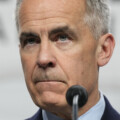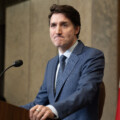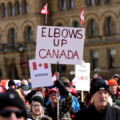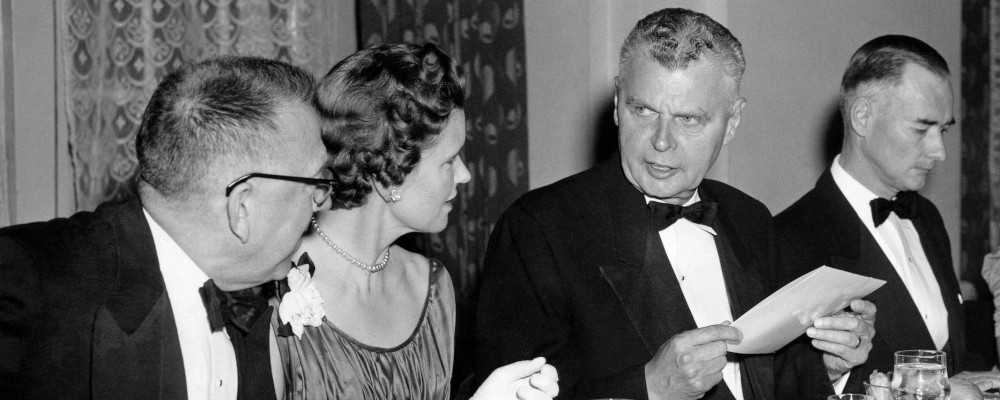In their 2014 book The Big Shift, Darrell Bricker and John Ibbitson boldly predicted that new Canadians would be instrumental in making the Conservative party Canada’s Natural Governing Party for the 21st Century. Recent immigrants, they argued, were broadly supportive of conservative governing principles and geographically concentrated in Canada’s most “must-win” suburban swing ridings—critically the seat-rich 905 region encircling Toronto—making the Conservative party’s continued electoral dominance a demographic inevitability.
Bricker and Ibbitson could hardly be faulted for their bullishness on the Big Blue Machine. Three years prior to the book’s publication, the Stephen Harper-led Conservative party steamrolled its way to its first majority government in over two decades, coming within one seat of sweeping the 905 and winning 29 of 44 total seats in the Greater Toronto Area. The “blue tsunami” that swept through southern Ontario was, above all, a reflection of the party’s rising tides among immigrant voters. The party won an impressive 16 of the 29 ridings across Canada where immigrants made up more than 50 percent of residents. (In the campaign’s English-language leaders’ debate, Conservative leader Stephen Harper endorsed multiculturalism and boasted about record levels of immigration under his watch). The Conservative Party of Canada’s breakthrough with immigrant and minority groups was unprecedented among Western conservative parties, garnering high praise from global conservative thought leaders like future British Chancellor of the Exchequer Rishi Sunak.
Of course, it would all come crashing down just one year later, when the Conservative party came out on the losing end of an ugly 2015 federal election campaign dominated by questions relating to the “reasonable accommodation” of Muslim immigrants. The 78-day campaign undid over a decade of constructive bridge-building with ethnic minority communities, eroding Conservative gains in the GTA and fracturing the heretofore insurmountable “Harper coalition” of Western populists and upwardly mobile suburban immigrants.
The cataclysmic 2015 election casts a long shadow over Canada’s conservative movement. The inability of successive Conservative campaigns to recover lost territory in the GTA and other immigrant-heavy parts of the electoral map has kept the Conservative party relegated to the opposition benches for seven long years. If anything, the party has become even more alienated from minorities over this stretch: top-ranking Conservatives have been photographed wearing “Make America Great Again” hats and rubbing shoulders with alt-right connected freedom convoy organizers; the party fields a shadow cabinet that has all the diversity of a J.Crew catalog; the controversial disqualification of Brampton mayor Patrick Brown from the party’s leadership race has left South Asian organizers feeling “disenfranchized and disregarded“.
Currently, Canada adds about 400,000 new immigrants a year. Although language is an imprecise measure of country of origin, the number of Canadians who speak Mandarin and Punjabi at home saw the biggest increases since the 2016 census.These 6 graphics show how language is changing in Canada https://www.cbc.ca/news/canada/census-data-2021-languages-graphics-1.6554035 A quarter of Canadians now have a first language that is neither English nor French. The bulk of these new immigrants are economic immigrants who move to cities and suburbs. As we are currently in the middle of an electoral redistribution, it would be reasonable to expect that cities would continue to gain seats at a faster rate than rural areas. Constituencies are drawn up based on population, so areas where the population is increasing should expect to gain more seats. If a party wishes to win power, it must win seats. Unfortunately for the Conservative Party of Canada, neither the elections fought in 2019 nor 2021 yielded much of a breakthrough in those seat-rich areas identified earlier.
It is worth noting that this is not necessarily reflective of an ideological problem with Canadian conservatism itself; after all, Doug Ford handily won the same areas Erin O’Toole failed to win just eight months prior. This of course begs the question: what do Ford and Trudeau have in common that Erin O’Toole and Andrew Scheer lacked? More than anything else, it’s that those two are excellent retail politicians: they are perceived as caring for the people they claim/wish to represent. However, it is impossible to make the argument that you care for a particular group if you are perceived as actively working against that group’s interests. The question then becomes, what does the party need to do to reclaim its brand with new Canadians?
As first-generation Canadians of colour, we were initially drawn to the conservative movement for its emphasis on hard work, fiscal prudence, and personal responsibility—values we saw mirrored in our own cultural communities. We have stuck by the Conservative party through its time in the political wilderness because, for all its faults, it is the only federal party that holds these values at its core. The party can find its way back to government and, more importantly, rediscover its soul by returning to a unifying, large-tent conservatism rooted in an ironclad belief in the universality of human dignity. A conservatism of one of our most revered figures: John Diefenbaker.
“Diefenbaker’s ethos of inclusion and vision for ‘One Canada’ would lie at the heart of his triumphant 1958 re-election campaign”
Diefenbaker, the grandson of German immigrants, was born in Neustadt, Ontario in the fall of 1895. After spending his early years in different parts of the province, he moved west to the prairies with his family in the early 1900s, eventually settling in Saskatoon (where, per Canadian folklore, a young, newspaper-shilling Diefenbaker would have his famous 1910 encounter with then prime minister Sir Wilfrid Laurier).Fostering a Vision for Canada: The Diefenbaker Legacy https://diefenbaker.usask.ca/exhibits/online-exhibits-content/fostering-a-vision-for-canada.php#FirmFoundations
Coming of age on the Canadian frontier, at a time when anti-German sentiment was on the rise, Diefenbaker developed a strong egalitarian streak early on in life; a sensibility that would only harden through his childhood and adolescent encounters with First Nations, Métis, Eastern European immigrants, and other “lesser Canadians”. He would later reflect on his formative years:
From my earliest days, I knew the meaning of discrimination. Many Canadians were virtually second-hand citizens because of their names and racial origin. Indeed, it seemed until the end of World War II that the only first-class Canadians were either of English or French descent. As a youth, l determined to devote myself to assuring that all Canadians, whatever their racial origin, were equal and declared myself to be a sworn enemy of discrimination.[emphasis added]
This would be Diefenbaker’s north star throughout his career as a criminal defence lawyer and, later, a Canadian statesman. After being called to the Saskatchewan bar in the summer of 1919, Diefenbaker set up a small practice in the village of Wakaw, a community of 400 composed primarily of Eastern European settlers. Just one year later, he was elected to the Wakaw village council at the age of 24, beginning a six-decade odyssey in politics—spanning the local, provincial, and federal levels.
Diefenbaker, whose German heritage was at times used against him by political opponents, stood unsuccessfully as a candidate in two federal elections, two provincial elections, and one mayoral election before finally winning a seat in the federal riding of Lake Centre, Saskatchewan in 1940. Entering parliament during the early stages of World War II, he immediately went to bat for Canadians with ethnic ties to Axis countries, speaking in defense of Canadians of German descent in his maiden speech to parliament. He also spoke out against the internment of Japanese Canadians, defying the popular opinion of the time. At the war’s conclusion, he voiced misgivings about the continuation of the prime minister’s “temporary” wartime emergency powers into peacetime and became one of the first major backers of a Canadian Bill of Rights, calling it “the only way to stop the march of the government towards arbitrary power.”
During his time on the opposition benches, Diefenbaker continually fought a two-front war against both the Bay Street controllers of the Progressive Conservative Party—who chafed at the idea of the party being led by a Prairie populist—and the Liberal machine in his home province of Saskatchewan (at one point, the Liberal government opened a home for unwed Indian mothers next door to Diefenbaker’s Prince Albert home in a futile effort to pressure him to move). By the time he took his place as leader of the Progressive Conservatives in early 1957, he was poised to take the moribund party in a new, populist direction. In a nationally televised address in advance of that spring’s federal election, Diefenbaker told Canadians:
[I’m] for a united Canada, for one Canada, for Canada first, in every aspect of our political and public life, for the welfare of the average man and woman. That is my approach to public affairs and has been throughout my life … A Canada, united from Coast to Coast, wherein there will be freedom for the individual, freedom of enterprise and where there will be a Government which, in all its actions, will remain the servant and not the master of the people.
This message would propel Diefenbaker’s Tories to a surprise victory over the heavily favoured Liberals, denying the Liberals their sixth consecutive federal mandate. Diefenbaker’s first cabinet included both the first ever woman (Ellen Fairclough) and the first Canadian of Ukrainian descent (Michael Starr) to be appointed to cabinet posts. He later appointed James Gladstone as the first First Nations member of the Senate.
Diefenbaker’s ethos of inclusion and vision for “One Canada” would lie at the heart of his triumphant 1958 re-election campaign; a campaign that would yield the Tories the largest electoral majority in Canadian federal political history. It was a campaign that, to this point in Canadian history, was unparalleled in the outpouring of public emotion it generated. Diefenbaker surrogate Michael Starr would later recall:
That was the most fantastic election…I went into little places…where nobody ever saw a minister…Every meeting was jammed…sitting there in the front would be the first Ukrainian immigrants with shawls and hands gnarled from work…I would switch to Ukrainian and the tears would start to run down their faces…I don’t care who says what won the election; it was the emotional aspect that really caught on.
The Progressive Conservatives won the majority of seats in eight of 10 provinces, falling just one seat shy of netting the majority of seats in British Columbia. The election’s decisive outcome was a testament to the power of Diefenbaker’s unifying message and proof positive that Canada’s manifold regional and ethnic divisions were not insurmountable.
While undoubtedly more of a campaigner than a governing executive, Diefenbaker nevertheless leaves behind an important legacy of accomplishments as prime minister. Above all, he strived to secure legal and social equality for all Canadians; extending the franchise to First Nations, striking racial clauses from immigration laws, and, of course, fulfilling his lifelong goal of passing a Canadian Bill of Rights. Pivotally, Diefenbaker was the first prime minister to push back against an exclusivist national myth that accorded special status to Canadians with English and French ancestry.
This is not to say that Diefenbaker was a nihilist who perceived Canada as a colourless postnational state. On the contrary, “Dief the Chief” espoused an assertive, values-based civic nationalism; an obstinate moralism that often rubbed other world leaders the wrong way. He cast the tie-breaking vote ejecting South Africa from the Commonwealth of Nations over its apartheid policies. He would later fall on his sword by taking a principled stand against the continued U.S. interference in Canadian strategic affairs amidst an intensifying Cold War. Diefenbaker’s loss to White House favourite Lester B. Pearson in the 1963 federal election led philosopher George Grant to lament, “The impossibility of conservatism in our era is the impossibility of Canada.”
As Ben Woodfinden recently wrote in The Hub, Diefenbaker embodied an ecumenical, anti-Laurentian strain of conservatism, seeing Canada as “more than just two founding nations” and, instead, a tapestry of “distinctive interests, identities, and histories.”A Tory impulse and anti-Laurentian ideas drive Canadian conservatism https://thehub.ca/2022-08-17/ben-woodfinden-a-tory-impulse-and-anti-laurentian-ideas-drive-canadian-conservatism/ Yet, over the six decades since Diefenbaker’s ouster, Conservatives have stood by idly as the Liberal Party has claimed the mantle of Canada’s “party of diversity.”
Canada’s Conservatives can find their way back from the wilderness (and back into government) by saying no to division and embracing the unifying, empowering brand of conservatism embodied by John Diefenbaker. A dog-whistle-free conservatism that appeals to the “silent majority” of minorities who are proud to be in Canada, are tired of being used as pawns in elite culture wars, and see high-priced “anti-racism consultants” as the hucksters they are.
The “One Canada” conservatism of “Dief the Chief” is big-tent conservatism that can win again.
Recommended for You

Laura David: Red pill, blue pill: Google has made its opening salvo in the AI-news war. What’s Canadian media’s next move?

The Notebook by Theo Argitis: Mark Carney’s first major tests

The Weekly Wrap: Trudeau left Canada in terrible fiscal shape—and now Carney’s on clean-up duty

Ben Woodfinden: Lament for an ‘elbows up’ nation



